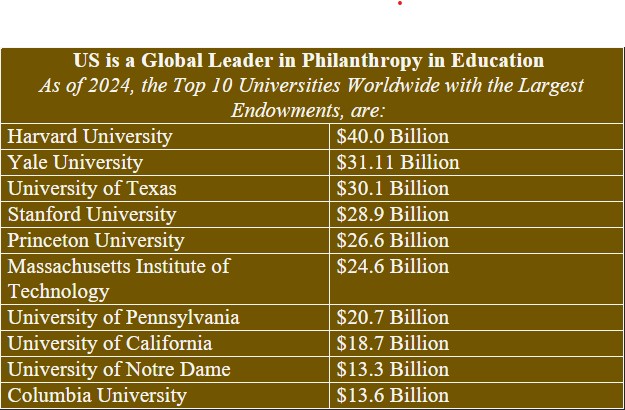Celebrating Indian philanthropy in higher education
This article is authored by C Raj Kumar is the founding vice chancellor of OP Jindal Global University, Sonipat, Haryana. He is a Rhodes Scholar.
India’s higher education sector has immense potential for making a substantive impact on the future of India. The demographic situation of India is poised to help us achieve higher levels of social and economic development. With more than a billion people who are less than 35 years of age, there is a natural aspiration for young Indians to seek opportunities to pursue university education. But this cannot be just an aspiration, it has to become a policy imperative. The National Education Policy (NEP) has envisaged an ambitious 6% target for Gross Domestic Product (GDP) investment in higher education but the reality is that actual investment is only 4%. The Gross Enrolment Ratio of India is 28%, although the aspiration of NEP is to raise this ratio to 50% in the next 10 years. This means that we need a large number of higher education institutions to be established at a relatively shorter span of time with significant investment at all levels.

All these points lead to only one direction. There is a need for significant expansion in the idea of private, not-for-profit, and philanthropically enabled higher education institutions in India. Given the need for significant capital for establishing these institutions in a short span of time to fulfil the needs and aspirations of the youth of India, our dependence on state funding has to be limited. Unfortunately, we also cannot promote private, mediocre, and for-profit type institutions, which will further exacerbate the challenges of access, equity and excellence.
It is in this context that we need to recognise the role of philanthropy in higher education institutions. The United States (US) has been the leading country in the world for spectacular success in building world-class universities and higher education institutions. In the fiscal year ending June 30, 2023, US colleges and universities received $58 billion (approx. ₹4,81,400 crores) in philanthropic support. In the fiscal year 2024-25, the Government of India allocated ₹47,619.77 crores to the department of higher education. Without much analysis, it can be reiterated that India needs significant capital infusion through philanthropy to help build world-class universities that will lay the foundations for the future of innovations in science and technology but also help building a knowledge economy and society.
Among the donors who helped to build American world-class universities, Andrew Carnegie is considered to be one of the most influential and charitable philanthropists in American history. From humble beginnings, he founded the Carnegie Steel Corporation, which became the largest steel manufacturing company in the world. He became the wealthiest man in the world after selling his company for $480 million. With his belief that, “The man who dies thus rich dies disgraced.”, he worked in earnest to give away his entire fortune before his death. In his lifetime, he built 2509 libraries, established the Carnegie Mellon University and Carnegie Corporation of New York, supported the founding and managing of the Peace Palace in The Hague, and numerous other institutions, setting a stellar example for the next generation of philanthropists.

Naveen Jindal, albeit being the chairman of one of the leading steel manufacturers in India, Jindal Steel and Power, is perhaps more well-known for being a statesman, educationist and philanthropist. He entered the public arena long before his tenure as a parliamentarian, fighting for a decade leading to the historic judgement by the Supreme Court of India granting the right for an entire nation to fly the national flag at any time of the year. He served as a Member of Parliament in the 14th and 15th Lok Sabha from Kurukshetra and was elected for the third time to the 18th Lok Sabha, continuing to champion gender equality, economic development, and empowerment of youth. He became one of the new-age philanthropists who triggered a cultural renaissance of corporate philanthropy in the 21st century in Indian higher education by establishing OP Jindal Global University in memory of his father OP Jindal, along with other institutions. Honouring his alma mater, he also made the largest alumni gift given to the University of Texas at Dallas at that time and in recognition of his philanthropy, the School of Management is named as Naveen Jindal School of Management.
Akin to Andrew Carnegie, Naveen Jindal is also a steel tycoon--but their similarities don’t end there. Naveen Jindal has done what Andrew Carnegie did for American higher education; He has invested in education as a catalyst for social change and community impact in India. He recognised the transformative power of education and its ability to make positive change. By contributing to the establishment of universities such as OP Jindal Global University, Sonipat and OP Jindal University, Raigarh, and other institutions is to place belief in the future of India through education and its ability to empower the youth of India.
India needs more philanthropists of the likes of Andrew Carnegie and Naveen Jindal who despite the pinnacles of success in business and industry made substantial contributions to higher education through the power of philanthropy.
This article is authored by C Raj Kumar is the founding vice chancellor of OP Jindal Global University, Sonipat, Haryana. He is a Rhodes Scholar.
All Access.
One Subscription.
Get 360° coverage—from daily headlines
to 100 year archives.



HT App & Website







